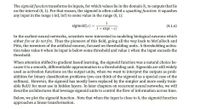
Computer Networking: A Top-Down Approach (7th Edition)
7th Edition
ISBN: 9780133594140
Author: James Kurose, Keith Ross
Publisher: PEARSON
expand_more
expand_more
format_list_bulleted
Question
please answer correctly

Transcribed Image Text:The sigmoid function transforms its inputs, for which values lie in the domain R, to outputs that lie
on the interval (0, 1). For that reason, the sigmoid is often called a squashing function: it squashes
any input in the range (-inf, inf) to some value in the range (0, 1):
1
sigmoid(a) =
(4.1.6)
1+ exp(-æ)"
In the earliest neural networks, scientists were interested in modeling biological neurons which
either fire or do not fire. Thus the pioneers of this field, going all the way back to McCulloch and
Pitts, the inventors of the artificial neuron, focused on thresholding units. A thresholding activa-
tion takes value 0 when its input is below some threshold and value 1 when the input exceeds the
threshold.
When attention shifted to gradient based learning, the sigmoid function was a natural choice be-
cause it is a smooth, differentiable approximation to a thresholding unit. Sigmoids are still widely
used as activation funetions on the output units, when we want to interpret the outputs as prob-
abilities for binary classification problems (you can think of the sigmoid as a special case of the
softmax). However, the sigmoid has mostly been replaced by the simpler and more easily train-
able ReLU for most use in hidden layers. In later chapters on recurrent neural networks, we will
describe architectures that leverage sigmoid units to control the flow of information across time.
Below, we plot the sigmoid function. Note that when the input is close to 0, the sigmoid function
approaches a linear transformation.
Expert Solution
This question has been solved!
Explore an expertly crafted, step-by-step solution for a thorough understanding of key concepts.
This is a popular solution
Trending nowThis is a popular solution!
Step by stepSolved in 2 steps with 1 images

Knowledge Booster
Similar questions
- Select number of movies grouped by year USING MySQL The Movie table has the following columns: ID - integer, primary key Title - variable-length string Genre - variable-length string RatingCode - variable-length string Year - integer Write a SELECT statement to select the year and the total number of movies for that year. Hint: Use the COUNT() function and GROUP BY clause.arrow_forwardPlease see the attached document and use kruskal algorithm please, Thanksarrow_forwardhow to Ask a user for their agearrow_forward
- Differentiate primary, candidate, and superkey.arrow_forwardUSING the SELECT statement, query the track table ordered by the bytes. Set the LIMIT to 5 and OFFSET to 5. What is the name of the last row returned? Snowballed Evil Walks Bossa Deixa Entrararrow_forwardwhat are the refernces you used?arrow_forward
arrow_back_ios
SEE MORE QUESTIONS
arrow_forward_ios
Recommended textbooks for you
 Computer Networking: A Top-Down Approach (7th Edi...Computer EngineeringISBN:9780133594140Author:James Kurose, Keith RossPublisher:PEARSON
Computer Networking: A Top-Down Approach (7th Edi...Computer EngineeringISBN:9780133594140Author:James Kurose, Keith RossPublisher:PEARSON Computer Organization and Design MIPS Edition, Fi...Computer EngineeringISBN:9780124077263Author:David A. Patterson, John L. HennessyPublisher:Elsevier Science
Computer Organization and Design MIPS Edition, Fi...Computer EngineeringISBN:9780124077263Author:David A. Patterson, John L. HennessyPublisher:Elsevier Science Network+ Guide to Networks (MindTap Course List)Computer EngineeringISBN:9781337569330Author:Jill West, Tamara Dean, Jean AndrewsPublisher:Cengage Learning
Network+ Guide to Networks (MindTap Course List)Computer EngineeringISBN:9781337569330Author:Jill West, Tamara Dean, Jean AndrewsPublisher:Cengage Learning Concepts of Database ManagementComputer EngineeringISBN:9781337093422Author:Joy L. Starks, Philip J. Pratt, Mary Z. LastPublisher:Cengage Learning
Concepts of Database ManagementComputer EngineeringISBN:9781337093422Author:Joy L. Starks, Philip J. Pratt, Mary Z. LastPublisher:Cengage Learning Prelude to ProgrammingComputer EngineeringISBN:9780133750423Author:VENIT, StewartPublisher:Pearson Education
Prelude to ProgrammingComputer EngineeringISBN:9780133750423Author:VENIT, StewartPublisher:Pearson Education Sc Business Data Communications and Networking, T...Computer EngineeringISBN:9781119368830Author:FITZGERALDPublisher:WILEY
Sc Business Data Communications and Networking, T...Computer EngineeringISBN:9781119368830Author:FITZGERALDPublisher:WILEY

Computer Networking: A Top-Down Approach (7th Edi...
Computer Engineering
ISBN:9780133594140
Author:James Kurose, Keith Ross
Publisher:PEARSON

Computer Organization and Design MIPS Edition, Fi...
Computer Engineering
ISBN:9780124077263
Author:David A. Patterson, John L. Hennessy
Publisher:Elsevier Science

Network+ Guide to Networks (MindTap Course List)
Computer Engineering
ISBN:9781337569330
Author:Jill West, Tamara Dean, Jean Andrews
Publisher:Cengage Learning

Concepts of Database Management
Computer Engineering
ISBN:9781337093422
Author:Joy L. Starks, Philip J. Pratt, Mary Z. Last
Publisher:Cengage Learning

Prelude to Programming
Computer Engineering
ISBN:9780133750423
Author:VENIT, Stewart
Publisher:Pearson Education

Sc Business Data Communications and Networking, T...
Computer Engineering
ISBN:9781119368830
Author:FITZGERALD
Publisher:WILEY